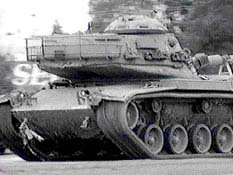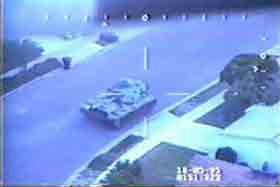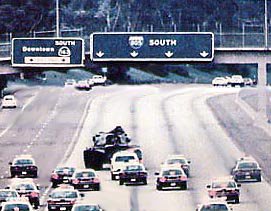Shawn Timothy Nelson was a US Army veteran and unemployed plumber who, at the age of 35 and under the influence of methamphetamine, stole an M-60 Patton Tank from a National Guard Armory in San Diego, California and went on a rampage on May 17, 1995 destroying cars, fire hydrants, and even an RV, before being shot dead by police.
Personal lifeEarly life
Nelson grew up in Clairemont and attended Madison High School. After training as a tank crew member in Fort Knox, Kentucky, Nelson served in the Army from 1978 to 1980, and was part of a tank battalion stationed in Germany. After leaving the army he served on a tuna-fishing boat in Panama. Later, he returned to San Diego.
He joined a plumbing company and quickly gained a reputation among the clients, who would ask for his services by name. He decided to leave the company and start his own plumbing business.
Problems begin
Nelson was hospitalized in 1990 for neck and back injuries. He sued the hospital for $1.5 million citing negligence, assault, battery, and false imprisonment. A superior court judge dismissed the case, and the hospital counter-sued for $6,640 in medical fees and legal expenses. Nelson claimed that he was forced to be treated without his consent.
After divorcing his wife of six years in 1991, and losing both his parents to cancer, Nelson started to lose control. According to his brother, Scott, Shawn Nelson started abusing drugs in 1993, and his life took a drastic change. Neighbors started reporting loud shouting arguments between Nelson and his roommate, calling the police on several occasions. As time went on Nelson started to exhibit very strange behavior. In particular, he dug a 15-foot hole in his backyard in an attempt to mine for gold and other minerals. In February of 1995, he filed a notice informing the county of his plans to mine bedrock in his backyard, even though he was not required to because his backyard was private property. Nelson's fishing friend, Carson Honings, referred to the mine shaft as an eccentric, but not obsessive, "new hobby." In April of the same year, he filed two damage claims against the city totaling $2,000,000. One of them was for police negligence, and the other for false arrest.
Nelson's neck and back problems, in addition to his plumbing equipment being stolen from his truck, effectively halted his business. With no income, his utilities had been cut off and his house was in foreclosure. In April of 1995, his live-in girlfriend died. Abusing methamphetamines and alcohol, and fighting depression, Nelson was in serious trouble. His brother, Scott, said of him, "My brother was a good man. He'd help anybody. He just couldn't help himself."
Tank rampage
According to San Diego police, the week before his tank rampage Nelson told a friend that he was thinking of committing suicide, and the following weekend, told a friend that "Oklahoma was good stuff," in apparent reference to the Oklahoma City bombing. Whether Nelson condoned the attack or simply meant that he enjoyed the drama is not clear. Police did not believe Nelson had any connection with the bombing or with a terrorist group.
At dusk of Wednesday, May 17, 1995, Nelson drove his Chevrolet van to the National Guard Armory in Kearny Mesa. Although the gate to the vehicle yard was usually locked after 5:00PM, employees at the armory were working late, and left the gate open. The vehicle yard was completely deserted. Nelson likely used a crowbar to break open the tank hatch. The first tank he broke into would not start, and neither would the second. As Nelson lowered himself into the third tank, a 57-ton M-60 Patton, he was finally noticed by a Guardsman, who approached the tank. Nelson managed to start the vehicle, and with little chance of stopping him, the Guardsman rushed to a phone and called police. Ammunition was kept in another building, so the vehicle's weapons were not loaded.
Nelson led police on a 23-minute, televised chase through the streets of the Clairemont neighborhood in San Diego, California. The tank had a top speed of 45 miles per hour, making the chase slow compared to police chases involving automobiles, but it was no less dangerous. The 57-ton tank easily plowed through road signs, traffic lights, and, in what's probably the most famous image of the chase, crushed a van up against an RV, and then plowed straight through the RV, before getting caught on a concrete median of California State Route 163, as he attempted to cross the median into the oncoming traffic. Four police officers climbed onto the tank. Officer Paul Paxton, a sergeant major in the Marine Reserves, cut open the hatch with bolt cutters. The officers ordered Nelson to surrender, but he said nothing and began lurching the tank back and forth in attempt to free it from the median. Afraid Nelson would free the tank and that the four officers would be thrown off, one of them fatally shot him.
ControversyPolice action
Question was raised whether or not it was necessary for the police to kill Nelson. Scott Nelson himself said police were just doing their job when they shot his brother. Police Captain Tom Hall said that if Nelson managed to free the tank, he "could have taken out no less than 35 vehicles that were passing at that moment." Additionally, police decided that if non-lethal action such as tear-gas was used, this might have stopped Nelson but not the tank, and officers would not be able to enter the tank if it was still moving and with tear-gas present. Barbed wire to tangle the treads was considered, but would not have been effective. Police officials called military personnel and discussed ways of stopping the tank, including using another tank, but all options were considered impractical.
News Coverage
Station KGTV/Channel 10 broadcast footage of Nelson's bloodied body being pulled from the tank by police both live and during the eleven o'clock news (it was this image that made Scott Nelson realize his brother was the one driving the tank). KGTV was the only station that decided to air this footage. While some people questioned whether it was necessary or appropriate for KGTV to show such images, KGTV then-news director Jeff Klotzman said, "We felt it was a critical part of the story. We warned our viewers three different times (before airing the footage) that it was graphic and it was." Dick Tuinings, news director of KUSI/Channel 51, supported Klotzman's decision, even though his own news program decided not to air the footage.
Armory security
Officials at the National Guard armory where Nelson stole the tank were criticized for what appeared to be a huge lapse in security, especially after the attack in Oklahoma City on April 19th of that year. In addition to the open, unguarded gate to the vehicle lot, the fence surrounding the lot had damaged barbed wire in some places. Residents near the armory said that even if the gate was locked, Nelson could have simply climbed the fence in sections where the barbed wire was damaged. Armory officials said that only a few people are given keys to the vehicles, that the vehicles were kept far away from fences to make them difficult to reach, that only someone with proper knowledge could operate and even start a tank, and that there was just no way to foresee such an event taking place. After Nelson's theft of the tank, security was tightened at the Kearny Mesa armory.
Shawn Nelson in popular culture
A documentary film was made that was based on the incident, called
Cul de Sac: A Suburban War Story. Nelson was memorialized by rock musician Mojo Nixon in his song "Tankman Blues" from his 1999 album "The Real Sock Ray Blue".









 Monday was odd documentary day on The Sundance Film Channel and I was able to sit down and watch one short one. It was called Cul de Sac: A Suburban War Story. It's an obscure little work about Shawn Nelson, the guy that in 1995 stole a tank and, until the police killed him, roared along a street in Clairmont California, smashing cars and tearing down traffic poles.
Monday was odd documentary day on The Sundance Film Channel and I was able to sit down and watch one short one. It was called Cul de Sac: A Suburban War Story. It's an obscure little work about Shawn Nelson, the guy that in 1995 stole a tank and, until the police killed him, roared along a street in Clairmont California, smashing cars and tearing down traffic poles.